Why does a spider mite appear on indoor plants? How to destroy a spider mite on a houseplant
On houseplants is one of the most nasty nowadays pests. It is a small spider of a reddish or brownish hue, which prefers to settle on the lower leaves of flowers. It is noteworthy that the development of one generation under favorable temperature conditions is possible every 12 days. After the settlement of such an insect, a small cobweb with small pieces of white dust forms in the corners of the leaves. If the pest is multiplied excessively, such a web can be literally enveloped in a whole plant.
External signs of the affected plant
A spider mite on indoor plants feeds mainly on juice, which it receives by piercing leaflets. Subsequently, the affected flower is covered with small yellow spots and dries up. After losing a large number of leaves, the plant may even die. The favorite place of residence are ficus, lemons, palms of various species, as well as cacti.
Fighting spider mite. Preventive actions

How to get rid of spider mites. Expert advice
Remember: a settled spider mite on indoor plants does not like water. Spray the flowers as often as possible, and then this problem will bypass you.  In addition, in addition to ordinary water, you can also use solutions such as "Fitoverm", "Intavir", "Carbofox" and many other drugs. After this treatment, it is better to place the pot for several hours in a plastic bag, so that the chemicals are completely absorbed, and the effect manifested itself more quickly. If the mite has already settled on your windowsill, you need to move on to offensive measures. For this, the flowers can be sprinkled with phosphoric or sulfuric preparations, and the treatment must be thorough. Once a week, you can alternate the drugs, so that the insects do not appear to them immunity.
In addition, in addition to ordinary water, you can also use solutions such as "Fitoverm", "Intavir", "Carbofox" and many other drugs. After this treatment, it is better to place the pot for several hours in a plastic bag, so that the chemicals are completely absorbed, and the effect manifested itself more quickly. If the mite has already settled on your windowsill, you need to move on to offensive measures. For this, the flowers can be sprinkled with phosphoric or sulfuric preparations, and the treatment must be thorough. Once a week, you can alternate the drugs, so that the insects do not appear to them immunity.
If your indoor flowers are inhabited by this dangerous pest, you will probably be interested to learn how to get rid of spider mites.
Types of spider mites
The most common types of spider mites are Common spider mite, Red spider mites, Red spider mite, Atlantic spider mite, Savvdarga spider mite.
These pests are so small that sometimes they are not noticed at all and do not apply any timely measures to fight, which leads to significant damage to indoor plants and eventually to their death.
They reach ticks only up to one millimeter in length. Body color is usually pale yellow or pinkish red, depending on the season.
Live mites in their woven spider webs of entire colonies, in which can reside hundreds of individuals. At the initial stage of the lesion, they are attached to the underside of the leaf. They reproduce very quickly, because as adults they are already on the tenth - twentieth day after laying eggs.
How to determine in time that the plant is infected with a tick
Still not pleasant is the fact that mites easily and fairly quickly (under favorable conditions) move from one plant to another, capturing all large areas.
Causes of spider mites
Most often ticks are activated during the winter period when central heating works and the air in the apartments becomes dry. Plants that are near sources of heating, which are rarely watered and not sprayed, may well be amazed by a spider mite. Sometimes an already infected plant can be brought home by buying it in a store. As mentioned above, that this pest is practically invisible, and therefore, at first glance, it is difficult to determine immediately whether the plant is affected or not. 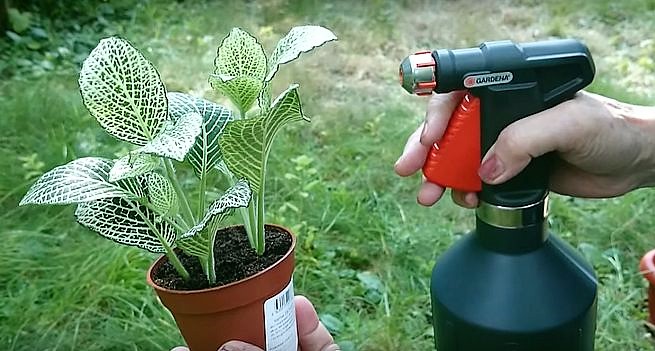
Preventive measures
Spider mites do not like high humidity, frequent airing and drafts, as well as direct sunlight. Therefore, in order to prevent frequent spray indoor plants from a finely dispersed sprayer, in time to water them, avoiding the drying of the soil. You can put a humidifier near the plant. This is especially appropriate in the winter, when plants stand on the windowsills, under which are located heating radiators and batteries. Wipe the leaves from the dust with a damp cloth, you can with the use of household or tar soap. It is good, as a preventive measure, to carry out to your houseplants a two-minute illumination session under an ultraviolet lamp, at least once a week. Often inspect your flowers and at the first signs of the appearance of pests, isolate it from others, so as not to infect the mite with all your home collection. Be careful when you bring a new plant into the house. Place it separately for a while, in quarantine. Purchased soil or mulching material, before use, it is desirable to be baked in the oven or microwave.
All these measures are certainly good and useful, but if the spider mite settles on your plants, then it is necessary to fight it more thoroughly.
Methods of fighting ticks
Finally, it is difficult to withdraw a spider mite. Since his eggs can survive for many years, under the first favorable conditions, the cycle of defeat again resumes. Sometimes even careful processing of all plants with appropriate preparations does not guarantee that your house will no longer have ticks.
Beginning the processing of your plants, wrap the pot with a cellophane bag and tie it around the stem with a thread. This is done so that the land does not wash out and wake up. Under a stream of running water with a shower head, rinse the affected plant well.
IMPORTANT! A plant such as the Umburian Senpolia or, as it is still popularly called, the violet does not tolerate the moistening of the leaves. They should be cleaned with a dry brush.
After thorough washing, the plant is covered completely with a transparent bag and placed in a shaded area (it is important that the sun is not exposed and the plant is not burned). Staying a few days in such a greenhouse, it's better a week, adult mites die, which can not be said about eggs. They must be dealt with by special chemical means.
Wash the windowsill or the place where the flowers were, using a soapy solution. You can walk on the surface with a cloth soaked in medical alcohol. 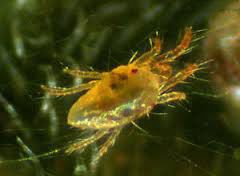
Chemicals for the control of a spider mite
Recently, industry has begun to produce special chemicals - acaricides and insectoacaricides.
Among them are popular drugs such as: Akarin (agravertine), Apollo, Envidor, Borneo, Floromite, Omayt, Sanmayt, Vertimec, Kleshchevit, Akarin, Agravertin and many others.
IMPORTANT! All chemicals are harmful to human health and pets.
To prevent ticks from developing protective immunity, the use of different drugs should be alternated.
IMPORTANT! To treat plants with serious chemical agents is necessary in protective gloves and a mask, and only in the open space of a yard or street. In extreme cases, spray the plants in the bathroom, followed by airing the room.
It is desirable to produce the treatment in dry, windless, warm weather. After spraying the drug, leave the plants in the open air for a while until they dry sufficiently. From time to time it is necessary to repeat the treatment with chemicals. The time interval between them depends on the air temperature. If the temperature is plus twenty degrees, three treatments should be done at intervals of nine to ten days. If the air temperature is thirty degrees and above, it is necessary to process three to four times with an interval of three days.
Safe means
You can try to deal with a spider mites and safer folk remedies. Of them, the cyclamen root, garlic, dandelion, chamomile, horseradish, tobacco, horse sorrel.
Of all these plants, a decoction is prepared, which is treated with affected indoor flowers.
Cyclamen
Apply the decoction from its root. Shredded tubers should be boiled for half an hour. The cooled solution is filtered and the plants are sprayed. After a week, the procedure can be repeated.
Dandelion
Infusion of dandelion roots is cooked about the same. Take thirty grams of ground roots per liter of water. Infusion, before using it, give some time to brew.
Garlic
Two hundred grams of peeled and chopped garlic pour a liter of water and insist a week. For the treatment of plants, six grams of the obtained infusion is mixed with a liter of water.
IMPORTANT! For people who are particularly sensitive to sharp smells, this method may not work.
Tobacco
Four hundred grams of a dry plant is insisted in a bucket of water for a day. Then infusion boil for two hours, filter and diluted in ten liters of clean water with the addition of fifty grams of master soap.
Horseradish
Roots along with the stems are passed through a meat grinder. A ten-liter bucket is filled with crushed horseradish about one-third and filled to the brim with water. Insist one hour. Then the strained infusion is diluted a little with water and sprayed onto affected plants.
Chamomile
It can be used as dried (one kilogram plant), and fresh (three kilograms). Pour a bucket of water, heat up to seventy degrees and insist twelve to sixteen hours. Further, all filters and diluted with water two to three times. In principle, this infusion does not cause burns in plants, so it can be used and undiluted. Before spraying, you can add a little grated household or liquid soap. It is necessary that the infusion well adheres to the leaves of the plant and does not roll down.
Sorrel horse
The roots of sorrel should be stored from autumn. Three hundred grams of crushed roots are poured into a bucket of hot water and insisted for three hours. Then they act the same way as with chamomile infusion.
Do not forget that you need to watch and care for all the flowers. In time, water them, season them and spray them from time to time.
Spiders like to be populated in houses and apartments, bringing invaluable benefits: destroying pesky insects. The only harm they can cause is to clog the walls and corners with cobwebs. Get rid of or not from these neighbors - it's up to you, but what a tool will help make this harmless for people and pets, our article will tell.
Types of spiders living in the house and apartment
Many feel disgust or fear at the sight of spiders, and after all they are quite harmless representatives of fauna. Often the cause of hostility is ordinary ignorance. Only a small part of the spiders are really dangerous for humans. In houses and apartments, some innocuous representatives get along very well with us: a haymaker, a gray and black house, a spider-tramp and a horse.
Home spiders living on walls, ceilings and facades - gallery
Spider-haymaker prefers to settle near the windows 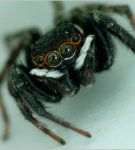 The black spider wove a beautiful spider web in the form of a pipe
The black spider wove a beautiful spider web in the form of a pipe 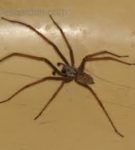 Spider-tramp does not weave cobwebs, but attacks the victim from ambush
Spider-tramp does not weave cobwebs, but attacks the victim from ambush  A spider-haired bird eats leaves
A spider-haired bird eats leaves
Each species has its own characteristics.
- Haymaking can be found next to the windows or in dry, warm places: pantry, bedrooms. They weave a huge web and hang in it upside down in anticipation of an insect.
- The size of a gray or black house spider does not exceed 2 cm. They are found on window frames, near light bulbs, on walls.
- The tramps do not weave cobwebs, they are always in motion. Quickly attack their victim, inject poison, eat and run to a new place for the next hunt.
- Skunk - a jumping spider with a pattern on the body. He does not eat insects, but prefers to use acacia leaves, that's why he often meets at the dacha.
The first spiders appeared on the earth about 400 million years ago. Nowadays there are more than 40 thousand species of these animals all over the world.
How do spiders get into our houses and apartments? We put them on clothes themselves or they make their way to the dwelling through the cracks. They live particularly well where there are many insects. If spiders do not find their food, then they will not become our neighbors for what.
If you are bitten by a house spider, do not be afraid. The only thing that can happen is burning and redness of the skin. Treat the bite site with any alcohol solution or peroxide and everything will pass.
Is it possible to get rid of such neighbors forever?
If your apartment is still occupied by unwanted guests and does not give you a pass, it is worth considering how to avoid an unpleasant "neighborhood". Residents of apartment buildings to bring out spiders together, because they easily move from one room to another.
The best way out in such a situation is to call in professionals who will conduct pest control and get rid of the problem. During the sanitation you will be asked to leave the premises, taking with you pets.

Professional disinsection helps to quickly get rid of all the insects that have settled the apartment
Please note that all the used products are chemicals, therefore do the following:
- remove all products;
- move the furniture away;
- after leaving specialists make a wet treatment and ventilate the room well to avoid poisoning.
Single pest control is not a panacea. There is a high probability that spiders will return after a while. In addition, note that spiders are not insects, so some funds for them may not work at all.
How to remove spiders on your own in an apartment or a private house
If you want to get rid of spiders on your own, first find out why they have appeared. If the cause is in small insects, get rid of them. Seal all cracks, crevices, so as not to give unwanted guests a chance to make their way back to the dwelling. In addition, take and such measures:
- go through all the corners and places of the accumulation of the web with a broom or a vacuum cleaner;
- glue the fallen off wallpaper;
- hang mosquito nets with small holes on the windows and ventilation grilles.
Another tip for dwellers or a private house: turn off the light from the outside. It flies moths, moths and other small insects that attract spiders.
The fight against chemicals
The most common means of struggle is "Dobrokh FOS", made on the basis of active substances chlorperiphos and fenthion. Insecticide is effective against ticks and all types of insects. For spiders, it also represents a real threat. The chemical breaks the passage of the nerve impulse, causes convulsions, paralysis and, as a result, rapid death.
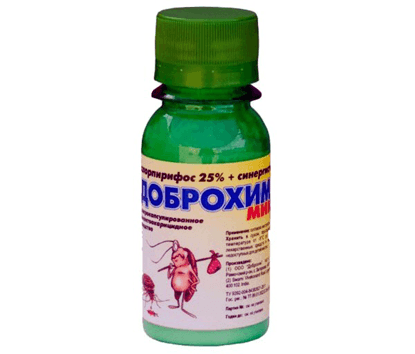
Good FOS is a good tool for getting rid of spiders in an apartment or a private house
Instructions for use.
- Dilute the product from the calculation of 10 ml per 1 liter of water.
- Take the children and animals out of the room.
- Spray the solution in the habitat of spiders, trying to get on them.
- After processing, exit the apartment and leave the windows open.
- On your return (no earlier than a day), do a wet cleaning.
The duration of the drug is 1-1.5 months.
Another proven tool is Butox 50. It has a wide spectrum of insect-acaricidal action. Once in the body of a spider, it causes paralysis, and then lethargy with a fatal outcome.
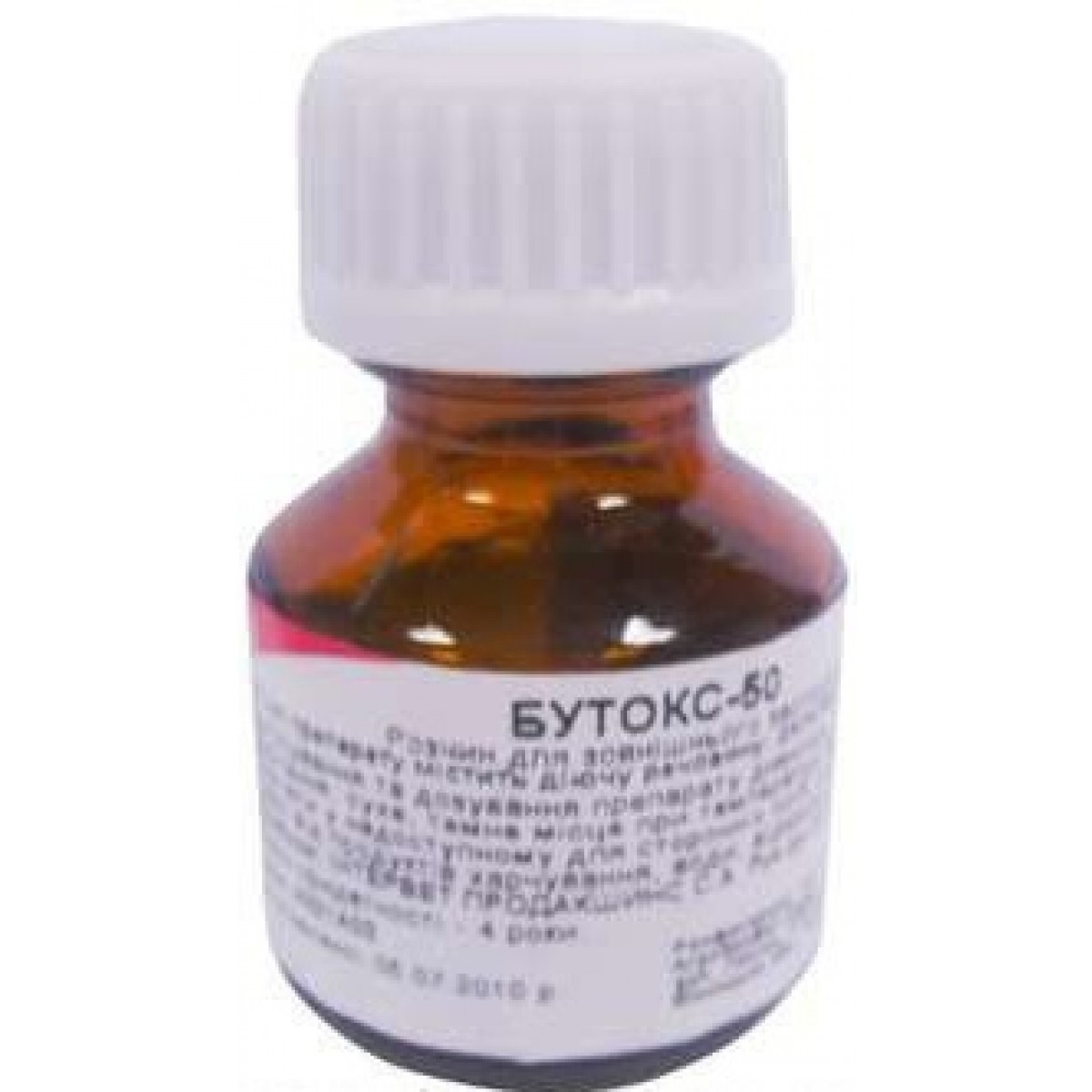
Butoks 50 - a powerful poison for fighting spiders
Method of application of the preparation.
- Dilute 30 ml of the drug in 10 liters of water.
- Spray the places of the accumulation of spiders.
- After 20 minutes, ventilate the room and do a wet cleaning. Repeat the treatment if necessary.
The duration of the drug is 2 months.
When working with chemicals, always wear protective clothing, mask and gloves, after the treatment, wash your face and hands with soap.
We drive out spiders with folk remedies
You can try to destroy the spiders harmless domestic ways. They do not like sharp smells: citrus, horse chestnut, hazelnut. Grind the fruits and spread them in the places of the accumulation of spiders.
Do not tolerate spiders and the smell of essential oils, for example, mint and eucalyptus. To scare off, use a mixture of oil and water:
- pour a little water into the sprayer to water the flowers;
- add 15 drops of essential oil;
- treat the resulting liquid with all the places where spiders live.
You can dump pieces of cotton wool in butter, put them on a plate and put them where spiders live. For complete disposal, change fragrant scares every 2 weeks.
Fir oil is applied to padded disks and scattered in corners. The whole room will smell of needles and spiders will flee.
Cyanob
An unusual folk remedy is sheep's wool. According to reviews, the spiders are afraid of its smell.
Spiders are very afraid of any sheep's wool, whether it's a thread from a sweater or a scrap of fur itself. Maybe it will work, try it.
Kate
http://www.woman.ru/home/medley9/thread/3834411/2/
Vinegar is also effective in fighting spiders.
- Mix 9% vinegar with water in a 1: 1 ratio.
- Pour the liquid into the spray gun.
- Sprinkle spiders and places where they settled.
Instead of vinegar, you can use lemon juice.
Folk deterrents - gallery
 Spiders do not like the smell of citrus fruits, for example, oranges
Spiders do not like the smell of citrus fruits, for example, oranges  Essential oils repel spiders with a sharp odor
Essential oils repel spiders with a sharp odor 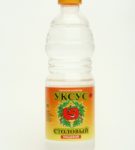 Table vinegar - a good tool to combat spiders
Table vinegar - a good tool to combat spiders  Lemon juice, diluted with water, will force the spiders to leave the chosen dwelling
Lemon juice, diluted with water, will force the spiders to leave the chosen dwelling
It should be noted that folk remedies for spiders operate for a short time. Once a sharp smell disappears, they can return.
We try insecticides, steam and ultrasound
Modern industry is inventing new ways to combat insects and spiders. Sprays in this series take first place. The most famous of them is Reid. Simply sprinkle on the spider from the can from a distance of 20-30 cm. The agent acts on the residual principle for about four weeks.
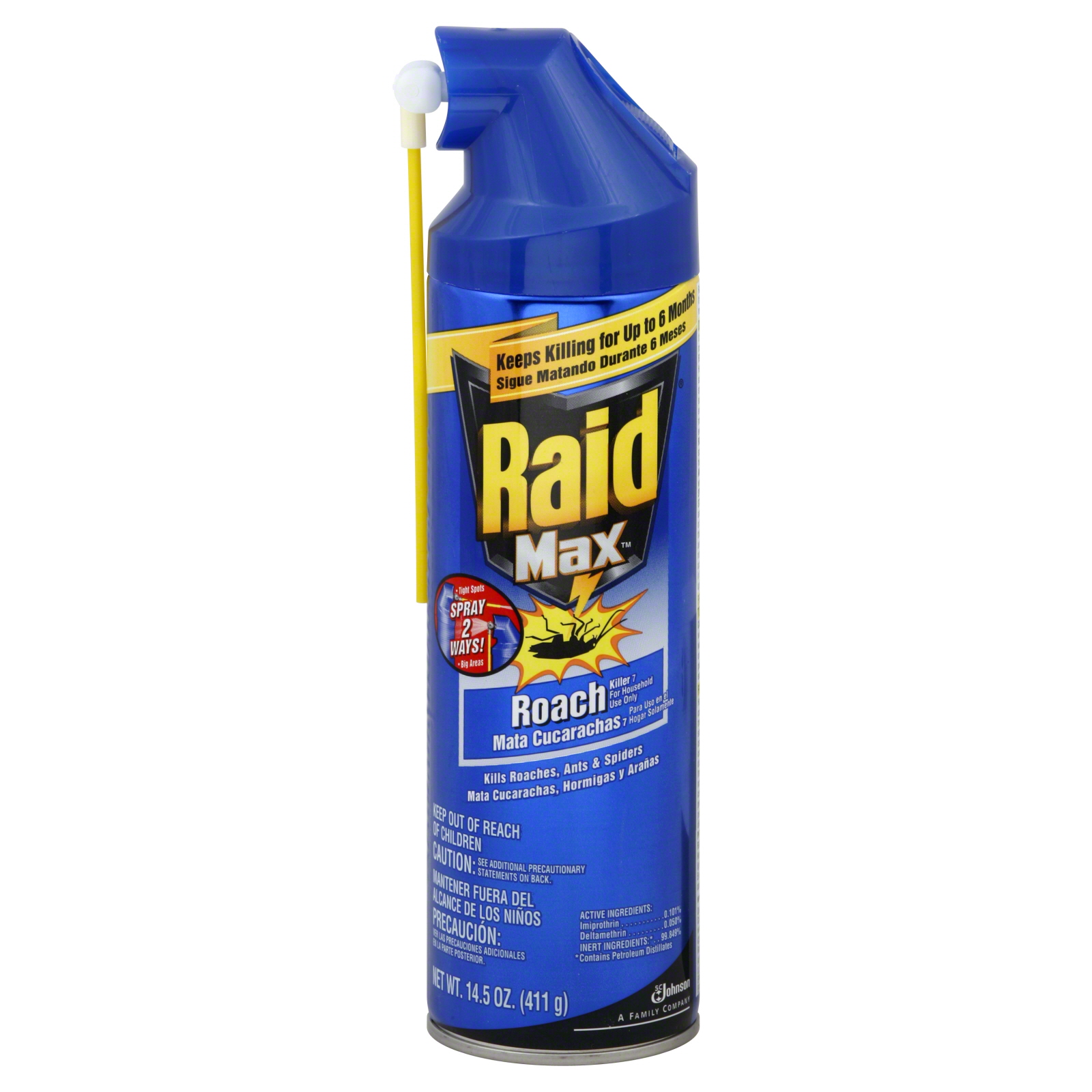
Reid is an effective spray against all kinds of insects and spiders
When using the spray, observe the precautionary measures:
- use the product only indoors, before removing people and animals from it;
- wear gloves, respirator;
- after finishing the treatment, leave the room;
- at the end of work, wash your hands with soap and water;
- clothes, on which the spray hit, immediately remove and wash.
People, cheers! Found a tool. Spray Reid from creeping insects (beetles, spiders, ticks, etc.). Sold in the garden and truck farming departments. Bank of purple. Sprayed all the corners, the windows in the country, they wriggle from them, fall and run away.
a guest
http://www.woman.ru/home/medley9/thread/3834411/2/
Another popular modern tool is aquafumigators. They are effective against all types of insects, including spiders. The most famous of them is Raptor. During the contact of this agent with water, a thermoreaction occurs, pairs of active substance are formed, which begin to penetrate everywhere, even in hard-to-reach places, and destroy all unwanted tenants.

Aquafumators fight insects and spiders with the help of a poisonous vapor
Mode of application:
- put the aquafumigator in a plastic container with water;
- leave the room for 2-3 hours;
- if necessary, retest after 2-3 weeks.
The least effective in controlling spiders are ultrasonic scarers. According to studies and reviews, in most cases they are simply useless.
It is believed that the cobweb in the house - to the money.
But in some houses spider webs are more than enough, but money is not added. Why? The thing is that the spider brings good luck only to those houses where a pleasant and warm atmosphere reigns. If there are constant conflicts in the family, then the spider, of course, will not harm, but do not expect that the manna of heaven will come down on you.
In general, a spider on a web is a good messenger, and in no case can it be killed. If this neighborhood does not suit you, then just take a stick or paper carefully, put a spider on it and take it out into the street.
The web, which remains, do not throw away, it can be useful to you. Gently pick it up and put it in a linen pouch sewn with your hands. Wear it always with you - it will be your luck charm.
If, when cleaning the room, you come across a web in the corner, then it says that the house has accumulated a lot of negative energy. The spider tells you this place, and in this case you should "clean" your apartment.
Spider for his ability to weave patterns was a mascot of housewives. Therefore, if you notice a cobweb under the table, a chair, a stove, a couch and other similar places, then this spider will help you in the household. Before you start any business, go to the web (even if there is no spider) and say 1 time a plot:
"As a spider knows his business, so I will know my business. As he skillfully weaves, so will my business also get on. May it be so!"
And what if you still killed the spider? Put it on a piece of paper, fold it 7 times and dig into the ground, saying 3 times the plot:
"Woe is not for me, there is no trouble. Ailment, go away, bring happiness back. "




